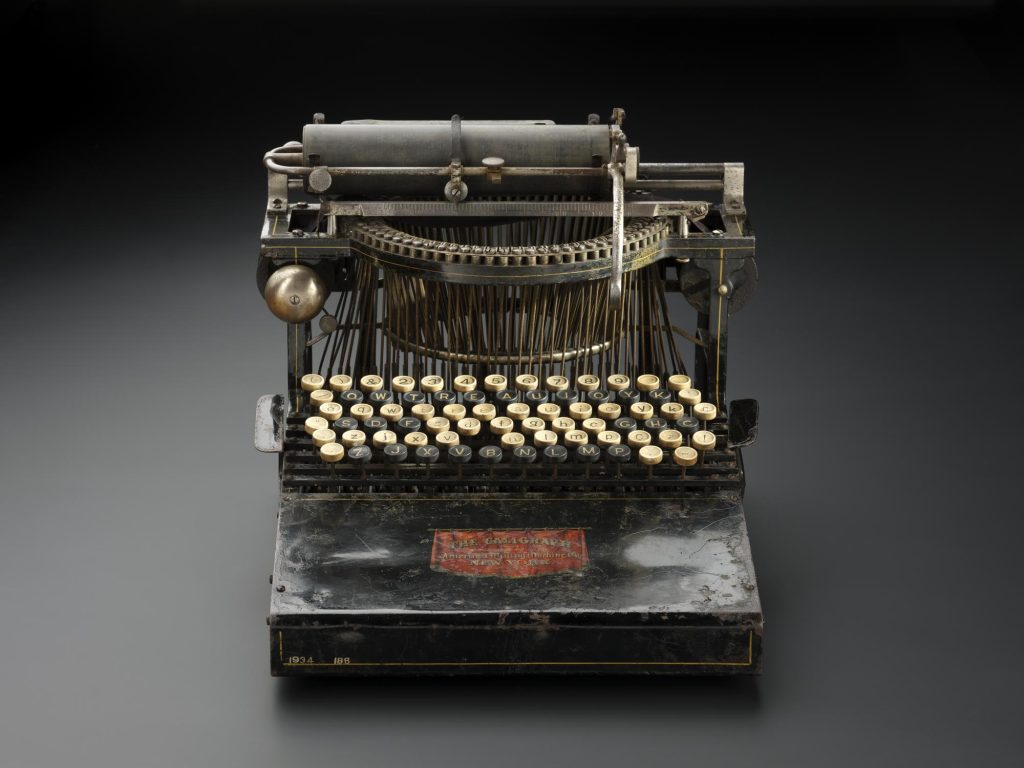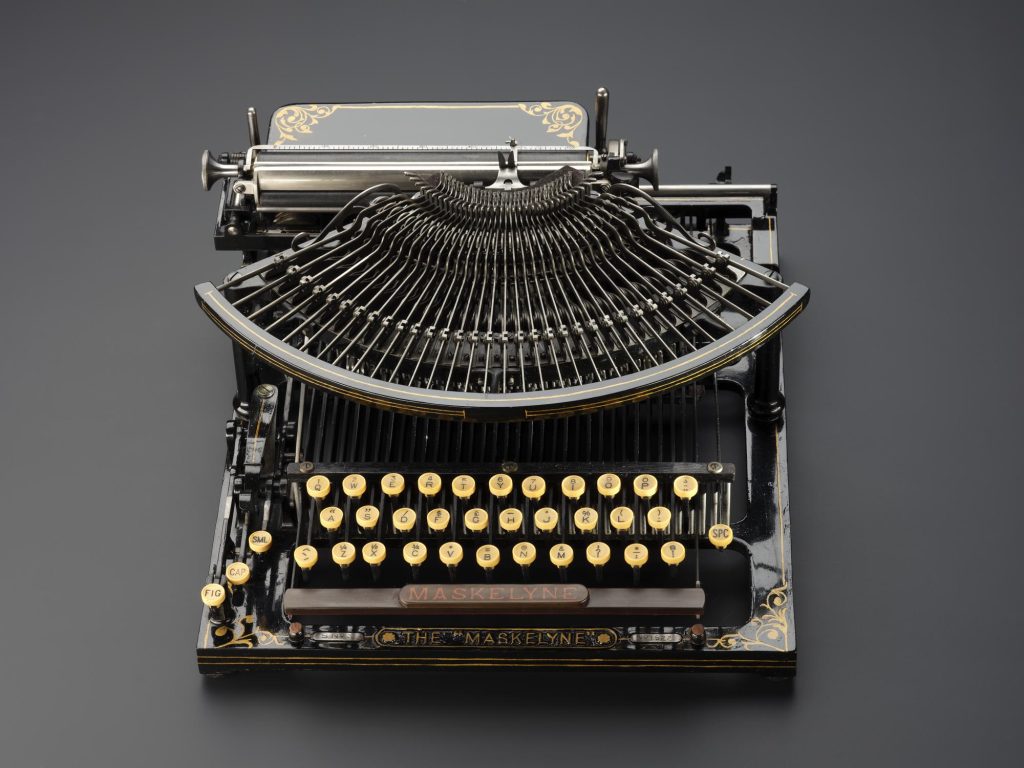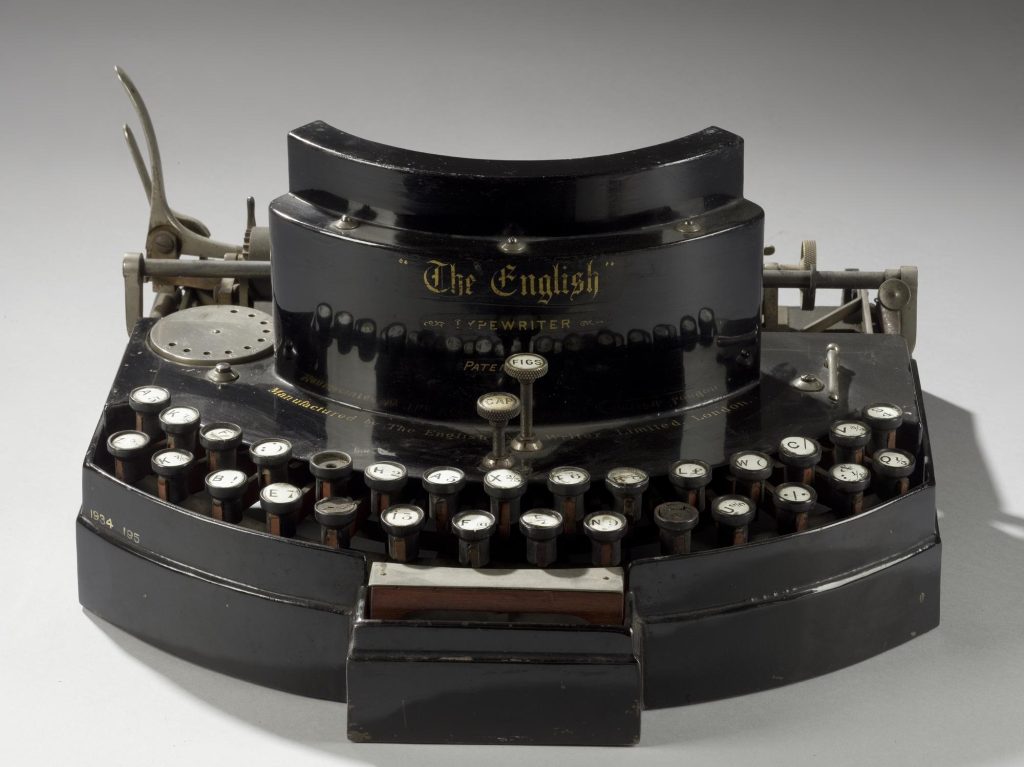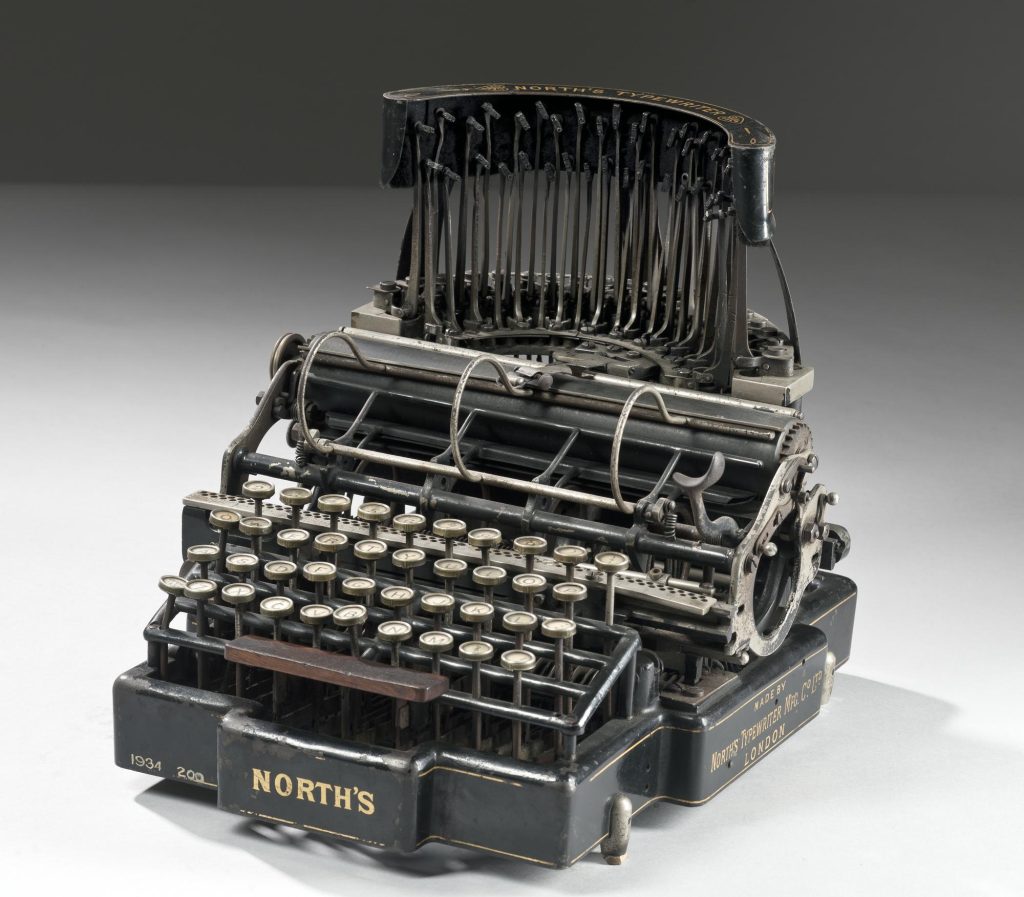When the first typewriters went on sale in Scotland in 1876, these American-made machines were little known novelties with few obvious customers. It took forward minded retailers to see the value in typewriters. One of the most successful was John J Deas of Dundee who pioneered the sale of typewriters in Scotland, which he marketed as “a machine to supersede the pen”.
John J. Deas was born in Dundee, Scotland in 1828. Deas followed his father into the textile trade as an assistant draper (a buyer and seller of fabrics). By the late 1850s, Deas owned his own store in Dundee which sold everything from flannels and blankets to hosiery and tartan handkerchiefs. In 1871, Deas put his drapery business to one side to focus on the sale of Kimball & Morton sewing machines, manufactured in Glasgow.
In an advertisement for his new product, Deas claimed the Kimball and Morton “broke the American Monopoly in Sewing Machines”, adding that “he is now devoting his whole time to the disseminating of these most useful articles.” In 1874, Deas became an agent for the Howe Sewing Machine Company, an American brand but with a strong presence in Scotland. Howe machines began to be manufactured in Bridgeton, Glasgow in 1870 and within two years their new factory was producing 41,000 sewing machines per year!
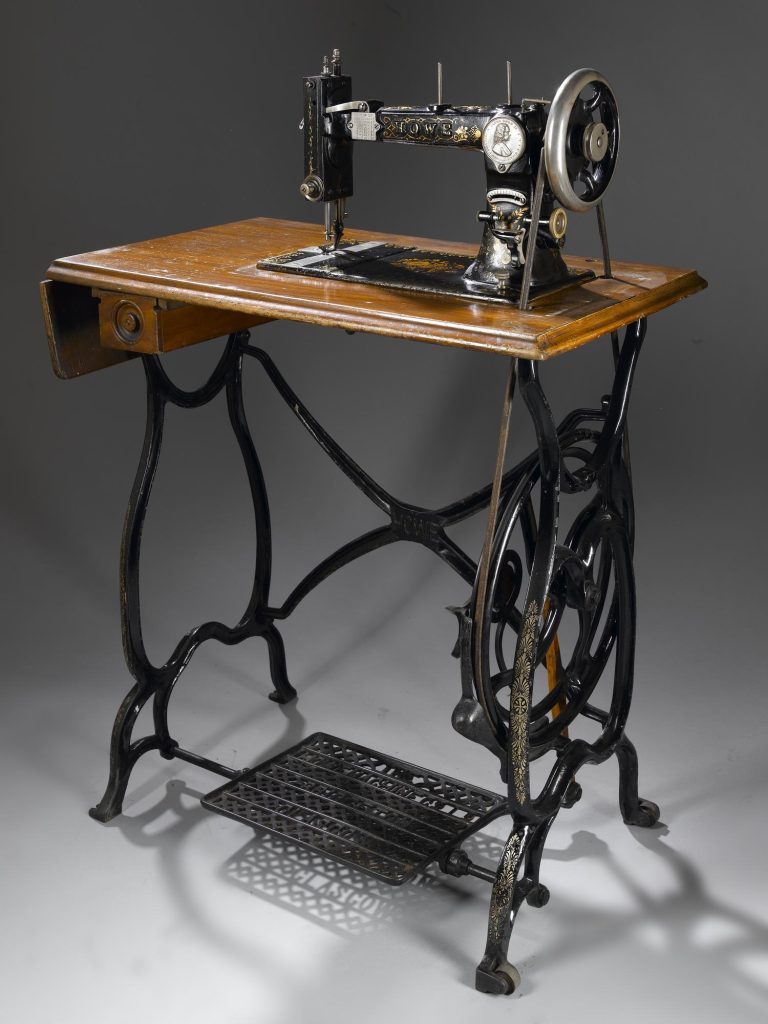
Not content with selling sewing machines alone, in 1876 Deas realised his greater retail ambitions with the opening of Deas’s Royal Machine Depot. In an advertisement for his new store at Morgan Castle, 137 and 139 Nethergate, Dundee, Deas explained:
“Ever since I went into the Sewing Machine Business six years ago, I felt convinced that there was an opening in Dundee for an Office where any kind of a Machine could be got. With the co-operation of some of the Largest Companies in the World, this idea has at length reached fruition in the Opening of DEAS’S ROYAL MACHINE DEPOT”.

As well as providing the “largest variety of sewing machines in Scotland”, Deas sold a range of goods, including knitting machines, darning machines, sweepers, gas stoves and telescope brushes. But for Deas it seems the most exciting of his new products was the “Type-writing Machines” which he sold for “£40, £26 and £21.” (well over half the average yearly salary at the time).
Agent for the Remington
Deas became the Dundee agent for the Sholes & Glidden typewriter in October 1876. This was a bold move, as the previous agents, GH&G Nicoll, had failed to sell a single typewriter in the previous nine months. Nevertheless, Deas was convinced that the typewriter had a future and initially at least his enthusiasm paid off. In his first month as agent, Deas managed to sell four Sholes & Glidden machines.

The first models of these typewriters had a treadle-operated carriage return system, similar to those on treadle sewing machines.

Around 1878, Remington released the “Perfected” Sholes & Glidden typewriter: the flowery decals were replaced with a plain black and green exterior, and the carriage return side lever was switched to a front lever similar to the design of modern typewriters.
Deas’ first customer was Baroness Burdett-Coutts (1814–1906), a philanthropist and one of the wealthiest women in the UK during the 19th century. As President of the Ladies Committee of the RSPCA, in 1871 she commissioned the statue of Skye Terrier Greyfriars Bobby, located just outside the National Museum of Scotland in Edinburgh.
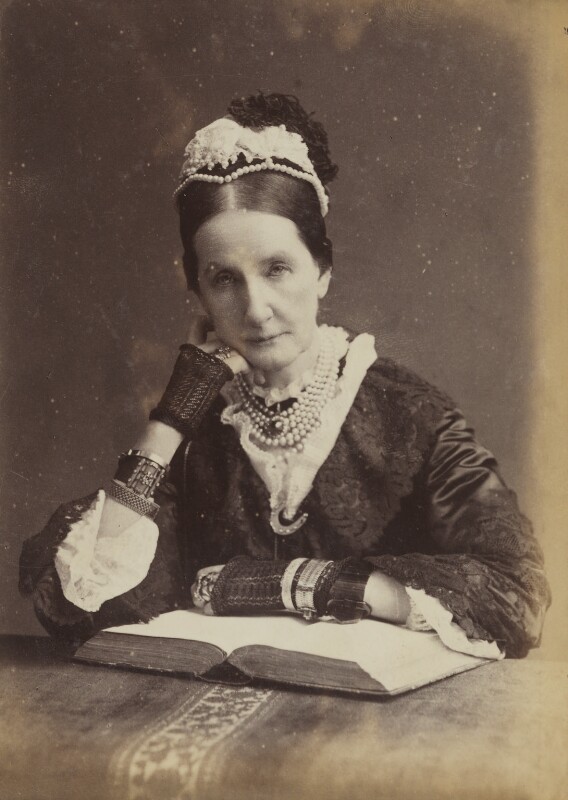
albumen print, 1882 NPG P1700(16d) © National Portrait Gallery.
Burdett-Coutts first saw the Sholes & Glidden at a private demonstration held at Deas’ Dundee home. According to Deas, she was so impressed by the “ingenuity displayed in its mechanism that she became the purchaser of the one exhibited”
Deas served as the agent for E. Remington & Sons until early 1883, during which time the company had developed a new typewriter: the Remington No. 2 Perfected Typewriter later known as the Standard No. 2.

Agent for the Caligraph
Deas made several influential contacts at Remington, including George Washington Newton Yost who had been instrumental in the development of the Sholes & Glidden and the Standard No. 2.
In 1880, Yost along with Franz Wagner released the Caligraph typewriter manufactured by their new enterprise, the American Writing Machine Company (AWMC). They produced a more robust version in 1882, which Yost sent to Deas in Scotland. This was reputedly the first Caligraph to arrive in Europe. Impressed by the new writing machine, Deas ended his contract with Remington and put his full support behind the Caligraph.
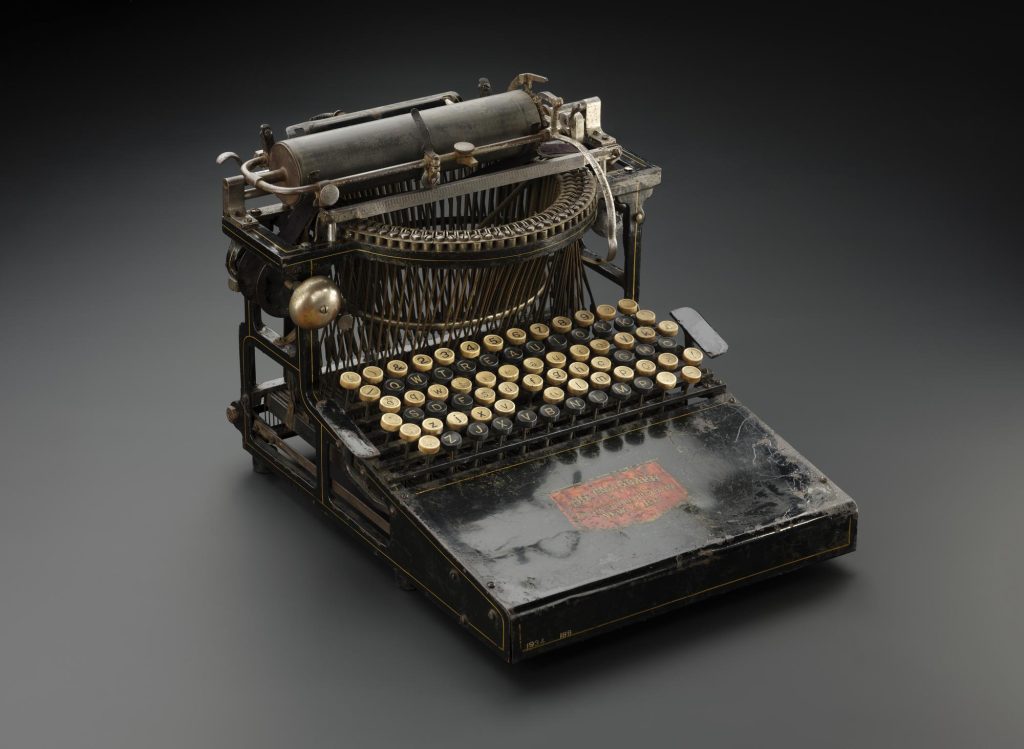
By 1884, Deas’ Dundee home at Ryehill House served as the European headquarters for the American Writing Machine Company. Deas had his Caligraphs imported on steamships, including the SS Devonia and the SS Anchoria, operated by shipping company The Anchor Line, which ran weekly between New York and Glasgow.
The SS Devonia was one of several Anchor Line ships which transported Caligraph typewriters from New York to Glasgow in the mid-1880s.
The first few Caligraphs arrived in Scotland in 1883 and, by the following year, Deas was importing around 12 cases per month. Deas also imported promotional materials such as the Caligraph Quarterly which was a “trade circular…designed to promote the introduction and general use of the Ideal Caligraph”. An advert published by Deas in 1884 informed readers: “All who require particulars [of the Caligraph] should send to Dundee for a Caligraph Quarterly a magazine devoted to Type-Writing news”.
Deas enthusiastically promoted the Caligraph through advertising in much the same way as he had done with his drapery and sewing machine businesses. In 1884, his announcement for a new Caligraph Office was published in the Aberdeen Post Office Directory. He describes each of the four models available with the all-capitals Caligraph 1 Ideal, also featured in the illustration.
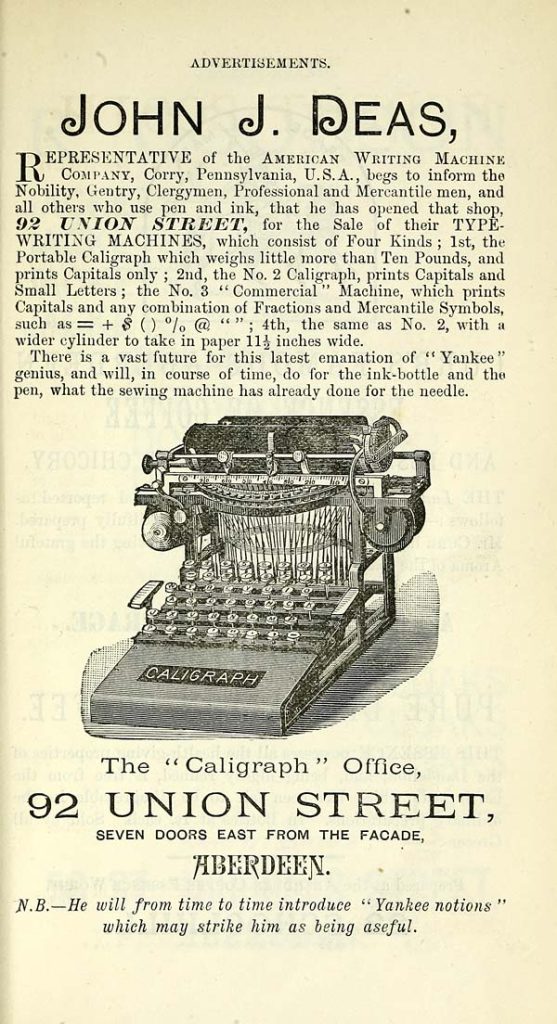
Drawing on his background in the sewing machine trade, Deas argued that the Caligraph “will, in course of time, do for the ink-bottle and the pen, what the sewing machine has already done for the needle”. The fact that the Caligraph was American only added to the glamour of the new invention. Deas joked at the end of his Aberdeen advertisement that, “He will from time to time introduce ‘Yankee notions’ which may strike him as being useful.” In the late 1880s, “Yankee notions” not only referred to ideas in the modern sense but to tangible consumer goods made in America, particularly from areas around New York. He could also be making reference to his previous trade as a draper, where ‘notions’ was the term for sewing accessories such as buttons, needles, thread; etc.
Throughout the 1880s, Deas continued to import typewriters from the U.S. and also sold various typewriters second-hand. He also sold Hall typewriters which were cheaper and more basic alternatives to a full keyboard typewriter.
Marketing the Deas Caligraph
In October 1889, the American Writing Machine Company set up a factory in Coventry, England, and it wasn’t long before Deas began ordering Caligraphs from the new plant. The Coventry factory was the first in Britain set up for the mass production of typewriters. A report on the factory from The Midland Daily Telegraph published in February 1892 claimed that the AWMC set up their works in “the city of cycles and watches and ribbons” because “they were able to obtain suitable labour, a central position, and were not likely to clash with any other local manufacture.” The Coventry factory, which was capable of turning out 130 Caligraphs per week, produced four models for the British and Imperial markets.
Deas had his own specially adapted typewriters built at the Coventry factory from 1890. In 1891, he announced to readers of the Dundee Courier:
“To my Friends in Dundee, Glasgow, Edinburgh and Aberdeen. I have just returned from Coventry, where I get the “DEAS CALIGRAPH,” Built to my Special Instructions… I can candidly – from an experience of nearly 16 years – Recommend the “DEAS” as being by far and away the Best Typewriting Machine on the Market.”
The new typewriter was Deas’ attempt to capitalise on his own reputation as a well-respected typewriter salesman with over 15 years of experience in the trade. While there are no remaining examples of the Deas Caligraph, an advertising postcard survives of Deas holding his typewriter. The image suggested that his typewriters may have come with a specially designed “Deas Caligraph” logo on the front panel, which would have replaced the standard red crest.
The Caligraph factory in Coventry was short-lived, closing within four years with manufacture continuing only in the US. Comments from US makers point to poor manufacture and increased costs as the reason, but this could be the result of protectionist bias. By the 1890s, there were already several typewriter manufacturers established in Britain, including the English, Maskelyne, Gardner and North’s. Most of them were short-lived, having disappeared by 1905.
Among the most successful was the Salter typewriter. It was manufactured by George Salter & Company, the famous makers of weighing scales and gauges in West Bromwich.
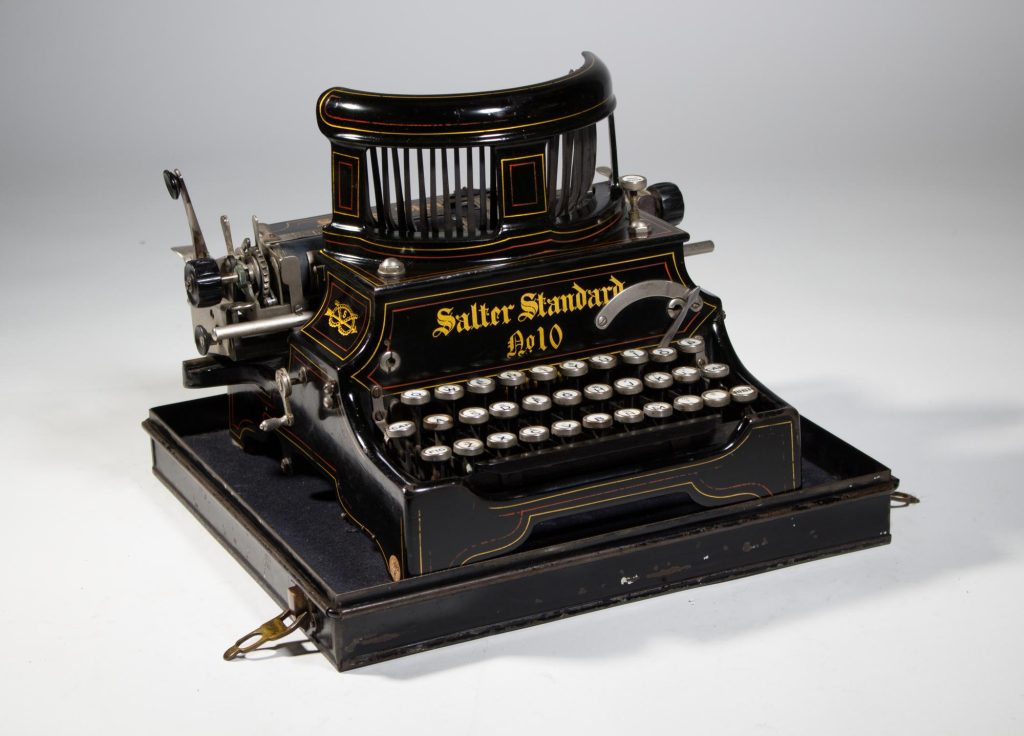
The last advertisements for the Deas Caligraph were released in late 1893, at around the time of the last newspaper accounts of typewriter production in Coventry.
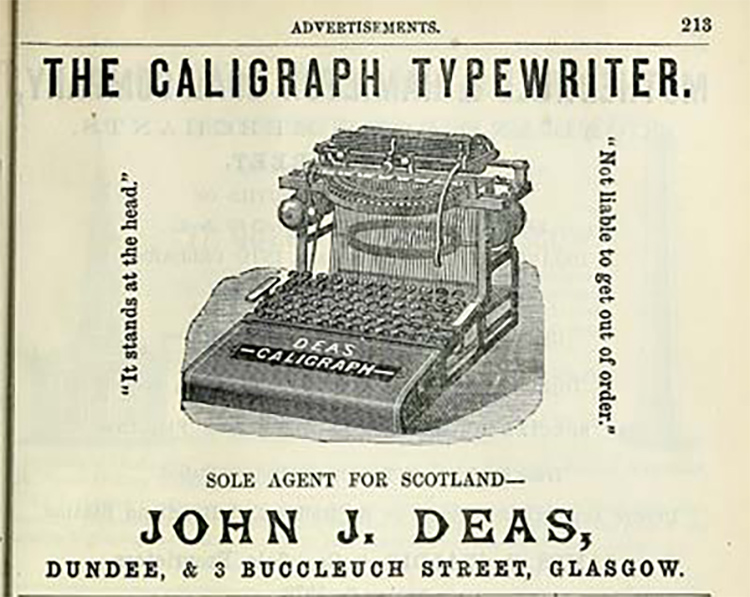
Deas continued to serve as the agent for the Caligraph in Dundee for the rest of his life, although in a less prominent role than before. His greatest legacy undoubtedly lay in his pioneering efforts to introduce the typewriter to Scotland. On his death in 1903, a friend said of him:
“He foresaw the coming of the type writer, and at a very early stage in the history of the machine he acted as its herald in this and other quarters. There are many Dundonians scattered all over the world who will learn with regret of the death of their old friend John J Deas.”
By the turn of the century, typewriters had been commercially available for 25 years. In that time, their use had shifted from an expensive novelty to a central feature in business communication processes, thanks in part to visionaries such as John J Deas.
This blog is a condensed version of an article published in the Journal of the Early Typewriter Collectors’ Association, (Summer 2021) and edited with guidance from typewriter historians Peter Weil and Paul Robert.
